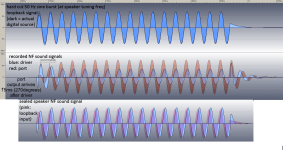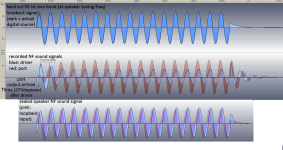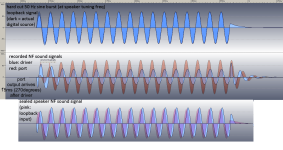I absolutely accept this. Does it necessarily follow that the step response and decay time of the systems are also the same?You can give a BR the same response as a sealed box if you want with some EQ'ing and vice versa.
A simple test would be to drill said small hole, apply DC to offset the cone inwards a meaningful amount, then seal the hole with a screw and rubber washer and remove the DC signal. The return to rest time can then be observed and measured.The myth of the idea that a small hole is needed in a sealed enclosure.
I believe it is not necessary, and never make holes in my sealed boxes!
Yes, since that is by definition the case with a minimum phase system.Does it necessarily follow that the step response and decay time of the systems are also the same?
simple test would be just to put a simple pressure sensor and a arduino inside the box as well as outside the box.A simple test would be to drill said small hole, apply DC to offset the cone inwards a meaningful amount, then seal the hole with a screw and rubber washer and remove the DC signal. The return to rest time can then be observed and measured.
I believe it is not necessary, and never make holes in my sealed boxes!
That will tell you a lot more.
The only thing is, even a "sealed" hole (for the wires) with caulk will already leak.
What mechanism in EQ-ing a sealed enclosure causes it to mimic the stored energy of a ported speaker's Helmholtz resonator, and consequential long decay times to a step response.
Looking at impulse response tests on DataBass we see decay times in excess of 100ms in very large, low-tuned enclosures as energy is released; would this truly be replicated in, say, a Q 0.5 sealed enclosure EQ'd to have the same frequency response?
I'm sorry but I simply cannot reconcile the two conditions in my head!
Looking at impulse response tests on DataBass we see decay times in excess of 100ms in very large, low-tuned enclosures as energy is released; would this truly be replicated in, say, a Q 0.5 sealed enclosure EQ'd to have the same frequency response?
I'm sorry but I simply cannot reconcile the two conditions in my head!
Within one cycle of what frequency? Ringing behaviour can be seen to produce tens of cycles of decay at a higher frequency than resonance as the envelope decays in the example I am looking at and it is still ringing past 250ms.
Do it - report back!I am not sure what you are getting at, but if I put a few fractions of a PSI into an otherwise sealed enclosure with an air fitting threaded into it, then close a valve with the cone displaced, you are alluding that the air will somehow escape magically?
I did such tests with real setups not just thinking about it, results are clear.
What's always with this whole ringing thing?
(rhetorical question, please don't answer)
In a minimum-phase system, ringing means a high(er) Q , which MUST result in a boost in the freq resp and a jump in the phase response.
Nothing more, nothing less.
There is literally nothing more to it from a minimum-phase point of view.
Thanks for your tests!Here you are, woofer and port at tuning frequency of 70 Hz recorded with two mics simultaneously and normalised to the same steady-state level. I've also attached the files so you can look for yourself. Let me know what you see here!
For a more realistic scenario it would be great to do a lowpass in front of the lf driver. Maybe even one at 80Hz and one at 350Hz for woofer/3way situation.
A "switching on" scenario needs a lot of high frequency content to be reproduced precisely - that's the job of the midrange/tweeter. This not a signal a lf driver will ever see!
But it's a good test to have a look what's going on!
p.s.: delay of the port - maybe your mic position is not the acoustical source of the port? This must not be at baffle level.
So no one thinks that a terminal post can leak? I've bought some that have the 4mm hole all the way through. Isn't it possible that ported speakers could suffer from the port flowing better in one direction than the other, like a bad one way valve; this would mean that during a loud bass passage, air would be pumped out, or into the speaker causing pressure to displace the cone.
If a single chamber, ported speakers can have delay and phase issues, would that mean that a double chamber, triple ported speaker would be much worse?
I don't realy like ports, but the 3 inch drivers (in ported boxes ) on the very cheap hi fi at work ( concrete floor, thick brick walls, L shaped room and pitched roof) seem to have better bass than 6 1/2 inch sealed drivers in my room at home, in a room that's almost a perfect cube, with wooden floor.
If a single chamber, ported speakers can have delay and phase issues, would that mean that a double chamber, triple ported speaker would be much worse?
I don't realy like ports, but the 3 inch drivers (in ported boxes ) on the very cheap hi fi at work ( concrete floor, thick brick walls, L shaped room and pitched roof) seem to have better bass than 6 1/2 inch sealed drivers in my room at home, in a room that's almost a perfect cube, with wooden floor.
I can sleep at night, quite fine thanks.Oh I see where the miscommunication started. I never advocated that a small hole was necessary, and I don't believe the steady state pressure in the box will ever be different than atmospheric (different enough to matter).
I was agreeing with @AllenB 's statement to @diyuser2010 assertion that a sealed speaker box could be made so finely that it would become a leak-free pressure vessel. Allen and I disagree with diyuser2010, we don't think a wood box could ever be so tight, and basic ideal gas law shows that even in an air tight box, it is not an issue with normal barometric variations.... but if he feels strongly about the issue, he should drill a small hole in his box so he can sleep at night.
In a car audio application, an enclosure can see -30F or colder in the winter time, and +115F in the summer, prior to the climate control bringing the temperatures towards room temp.
You don't think a wood box can be made air tight. I disagree.
I use speakon sealed connectors, and apply Sikaflex-221 around the connector and wiring inside the box.So no one thinks that a terminal post can leak? I've bought some that have the 4mm hole all the way through.
I would like to explore the idea that @DSP_Geek put forth in post # 58. Tuning a BR very low, and using EQ to make it flat. I occurred to me that in my sealed box systems, I always use DSP to EQ the bass, so a fair comparison to BR would allow the BR system to also use EQ.
Here is an SB34NRXL75-8 in a 100 liter vented box, tuned so that Fb=Fs=22 Hz. It results in a shelved response, but a 3 dB PEQ brings it back to flat. The F6 is at 21 Hz, and we hit Xmax at 34 Hz with 21 Vrms. At this drive level, we get 108 dB SPL at 30 Hz, and 109 dB SPL at 50 Hz. Since the tuning frequency is so low, group delay looks pretty good.



To compare to a sealed box, I used the same woofer in half the volume (50 liter). To be honest, this is not an ideal woofer for a sealed box application, the Qts is less than 0.3, so it needs more EQ boost than I would normally be comfortable with. The sealed box could have been made smaller, 40 liters would have given almost the same result. But this is a simplified theoretical comparison.
In a sealed box, we get an Fb = 49 Hz and Qtc=0.59, so this is a highly damped sealed box with a very gentle rolloff. I applied an 11 dB shelf EQ to get the same F6 as the vented box, 21 Hz. I increased the drive level until I hit Xmax at 34 Hz, just like the vented box. Drive level was 13 Vrms, where we got 103 dB SPL at 30 Hz and 105 dB SPL at 50 Hz.



So in this case, the vented box has a 5 dB SPL advantage over the sealed box. In terms of group delay, the sealed box has marginally better performance above 40 Hz. It is only below 40 Hz that the difference becomes significant. I have my doubts that group delay below 40 Hz is important. I was surprised at how close they were, and I don’t believe that the sealed box has a meaningful group delay advantage over the vented box.


Now assuming we have the space to fit a 100 liter box, what kind of sealed box system performance could we get? Putting two of these woofers in parallel now gives us a significant advantage over the vented box. Sensitivity and efficiency both go up, and max SPL under the same conditions is now 109 dB at 30 Hz and 110.8 dB at 50 Hz. As I pointed out before, the box size could be reduced without impacting performance. The only downside is the need to buy another woofer.

So this is interesting. Thank you @DSP_Geek for sharing this thought... j.
Here is an SB34NRXL75-8 in a 100 liter vented box, tuned so that Fb=Fs=22 Hz. It results in a shelved response, but a 3 dB PEQ brings it back to flat. The F6 is at 21 Hz, and we hit Xmax at 34 Hz with 21 Vrms. At this drive level, we get 108 dB SPL at 30 Hz, and 109 dB SPL at 50 Hz. Since the tuning frequency is so low, group delay looks pretty good.
To compare to a sealed box, I used the same woofer in half the volume (50 liter). To be honest, this is not an ideal woofer for a sealed box application, the Qts is less than 0.3, so it needs more EQ boost than I would normally be comfortable with. The sealed box could have been made smaller, 40 liters would have given almost the same result. But this is a simplified theoretical comparison.
In a sealed box, we get an Fb = 49 Hz and Qtc=0.59, so this is a highly damped sealed box with a very gentle rolloff. I applied an 11 dB shelf EQ to get the same F6 as the vented box, 21 Hz. I increased the drive level until I hit Xmax at 34 Hz, just like the vented box. Drive level was 13 Vrms, where we got 103 dB SPL at 30 Hz and 105 dB SPL at 50 Hz.
So in this case, the vented box has a 5 dB SPL advantage over the sealed box. In terms of group delay, the sealed box has marginally better performance above 40 Hz. It is only below 40 Hz that the difference becomes significant. I have my doubts that group delay below 40 Hz is important. I was surprised at how close they were, and I don’t believe that the sealed box has a meaningful group delay advantage over the vented box.
Now assuming we have the space to fit a 100 liter box, what kind of sealed box system performance could we get? Putting two of these woofers in parallel now gives us a significant advantage over the vented box. Sensitivity and efficiency both go up, and max SPL under the same conditions is now 109 dB at 30 Hz and 110.8 dB at 50 Hz. As I pointed out before, the box size could be reduced without impacting performance. The only downside is the need to buy another woofer.
So this is interesting. Thank you @DSP_Geek for sharing this thought... j.
The Italian manufacturer Ciare offers 8", 10" and 12" woofers suitable for Closed Box systems.The list of suitable drivers was not a long list.
I did ensure the input waveform started exactly from zero / center of the sine wave. So at least there is no additional HF content due to a DC jump.A "switching on" scenario needs a lot of high frequency content to be reproduced precisely -
Would it give the same result if we LP the recorded data? 🤔
Last edited:
Yes, so would I. This is only a simulation, so I don't have any measured distortion data. I do not have this driver in my collection at this time.I would be curious to see distortion figures in this simulation, especially below 33.8hz
The spectral energy content of music drops below 50 Hz (so I read), and it drops again below 40 Hz. This is why the Linkwitz Transform EQ works.
I listen to a lot of music that i am afraid to use sealed with the LT transform, unless a high-pass filter is also used.The spectral energy content of music drops below 50 Hz (so I read), and it drops again below 40 Hz. This is why the Linkwitz Transform EQ works.
Cost of that is,....... once the hpf is in place, the previously superior group delay vs ported, evaporates. Ye ole no free lunch again...
Really appreciate the detail you have put into documenting your port research.well ... I was just doing something very similar! 😊
here are my graphs, recorded with my current investigation loudspeaker, as shown here.
I used two sine burst signals at 50 Hz (bass reflex tuning frequency of my speaker), one with short fade-in and fade out cycles and one with hard start and stop
50Hz is a nice number to work with, 1000ms/50Hz=20ms being one cycle (360 degrees) duration time, each 90 degrees of phase 5ms.
At Fb (bass reflex tuning frequency) your "hard burst" test clearly shows the first arrival of the port output delayed by 15ms, (270 degrees) from the driver output:
We hear complaints about the amplitude level "ramp up" time of the port and it's decay time, seeing the ported compared to a sealed in this manner shows clearly shows what a static phase and frequency response chart can not:
The trend towards more compressed and "boomy" (little dynamics, slow decay) bass in pop music tends to mask the transient difference between enclosure designs.
Since the driver's excursion at Fb is at it's minimum between the two impedance peaks, a transient peak centered at Fb shouldn't be a problem compared to one on either side.as can also be seen in @Tenson's graph, during the first cycle of bass reflex speakers the driver has an increased excursion, because the resonator does not yet provide the counteracting air pressure.
I also observed something similar with my test bandpass enclosure, see here.
apparently the well known excursion limiting effect of resonator enclosures cannot protect a driver from transient high excursions.
That said, it's a difference I was not aware of, and would explain problems I've heard in some bass reflex alignments not designed to be maximally flat in the pass band.
Thanks for posting the test results!
Art
Attachments
- Home
- Loudspeakers
- Multi-Way
- Why are sealed box woofers out of fashion


